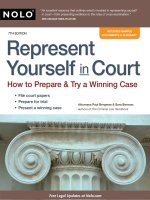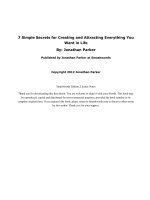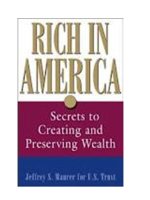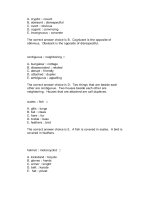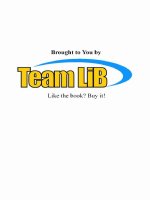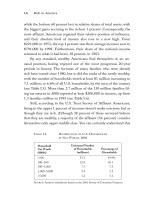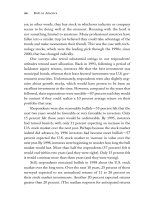Rich in America Secrets to Creating and Preserving Wealth PHẦN 6 potx
Bạn đang xem bản rút gọn của tài liệu. Xem và tải ngay bản đầy đủ của tài liệu tại đây (151.13 KB, 23 trang )
Date $ Amount Share Price
# of Shares
Purchased
Cumulative
Shares
Avg. Cost
Single
Category
Avg. Cost
Double
Category
Purchase
1–Jan–01 2,500.00 10.00
250.00
250.00
10.00
Dividend Reinvestment 30–Sep–01
75.00 10.75
6.98
256.98
10.02
Purchase
1–Jan–02 2,500.00 11.20
223.21
480.19
10.57
Dividend Reinvestment 30–Sep–02 152.
25 12.01
12.68
492.87
10.61 10.61
Purchase
1–Jan–03 2,500.00 10.95
228.31
721.18
10.71
Dividend Reinvestment 30–Sep–03
231.82 11.00
21.07
742.25
10.72 10.95
Assume all shares purchased in years 1 and 2 are l
ong term and all shares purchased in year 3 are short ter
m.
700 shares are sold at $11.50 per share. Sale occurs 10/
15/03.
# of
Shares
Selling
Price
Proceeds Basis
LT
Gain/Loss
ST
Gain/Loss
Total
Gain/(Loss)
FIFO Method
1–Jan–01 250.
00 11.50 2,875.00 2,500.
00 375.00
30–Sep–01
6.98 11.50
80.27
75.00
5.27
1–Jan–02 223.
21 11.50 2,566.96
2,500.00
66.96
30–Sep–02 12.68
11.50
145.78
152.25
(6.47)
1–Jan–03 207.
13 11.50 2,381.98 2,268.06
113.92
Total Gain/(Loss)
700.00
8,050.00 7,495.31 440.77
113.92 554.69
Specific Identification
30–Sep–02 12.68
11.50
145.78
152.25
(6.47)
(High cost lots first)
1–Jan–02 223.
21 11.50 2,566.96 2,500.
00
66.96
30–Sep–03 21.
07 11.50
242.35
231.82
10.54
1–Jan–03 228.
31 11.50 2,625.57 2,500.
00
125.57
30–Sep–01
6.98 11.50
80.23
75.00
5.23
1–Jan–01 207.
75 11.50 2,389.09 2,
077.47 311.62
Totals
700.00
8,050.00 7,536.54 377.35
136.11 513.46
Average Cost
492.87 11.50 5,668.01
5,280.98 387.02
(Single Category)
207.13 11.50 2,382.00
2,219.35
162.65
700.00
8,050.00 7,500.33 387.02
162.65 549.67
Average Cost
492.87 11.50 5,668.01
5,227.27 440.73
(Double Category)
207.13 11.50 2,382.00 2,
268.95
113.05
700.00
8,050.00 7,496.22 440.73
113.05
553.78
T
ABLE
3.2 T
AX
T
REATMENT OF
M
UTUAL
F
UNDS
120
03 Chapter Maurer 6/20/03 5:00 PM Page 120
your broker or fund company should confirm this decision, in writing,
within a reasonable period of time to you. If you choose not to use spe-
cific identification, you have a choice between the “first in, first out”
method (FIFO—the default method of the IRS) or the “average cost”
method. FIFO is exactly as it sounds. Shares acquired first are deemed
to be sold first, with the actual tax cost basis of the shares used to cal-
culate gain or loss. Average cost aggregates the tax cost of all shares to
calculate an average cost that is then used for any sales of those shares.
Of course, the average cost of your mutual fund shares will change over
time as new shares are added and old shares are sold. Once you choose
to use the average cost method for a particular fund method, you must
use it for all subsequent sales of that fund. The double category aver-
age cost method requires you to separate all your long-term and short-
term shares and calculate average cost for each category at the time of
the sale while the single category method calculates one average cost
for all your shares, regardless of holding period. (See Table 3.2).
Another advantage of mutual funds is that the fees charged by
the funds and expenses are deducted at the fund level. This generally
is more tax-efficient than fees paid for individually managed accounts
where total miscellaneous expenses (including investment manage-
ment fees) have to be greater than 2% of adjusted gross income.
Other Tax Issues
Alternative Minimum Tax
Yet another significant part of the tax code is something most people
haven’t even heard of. It’s called the alternative minimum tax (AMT).
The AMT is a separate and parallel tax system. It taxes a broader base
of income, with fewer deductions, at an essentially a flat rate. It is the
closest thing this country has to a flat tax.
Taxes 121
03 Chapter Maurer 6/20/03 5:00 PM Page 121
The AMT is calculated at a flat rate of 26 percent on alternative
minimum taxable income (AMTI) of $175,000 or less and 28 percent
on AMTI above $175,000. The one exception to this tax rate is for
dividends and net long-term capital gains incurred after May 6, 2003,
which are taxed at 15 percent, the same as the regular tax. The AMT
applies only when the amount you would owe under it exceeds your
regular income tax. For example, if your AMT tax share turns out to be
$75,000, while your regular tax is $50,000, you must pay an AMT of
$25,000 in addition to the $50,000 regular tax for a total tax of $75,000.
A modest exemption of $58,000 for married couples filing jointly,
$29,000 for married individuals filing separately, and $40,250 for sin-
gle and head of household taxpayers applies against AMT, thereby
limiting the exposure to AMT for lower-income taxpayers. The
exemptions are scheduled to decrease by $13,000 for joint return filers
and $6,500 for all others after 2004. Because of the new tax laws with
lower marginal ordinary rates, there is a narrower spread than ever be-
tween the AMT and the regular tax, and the base numbers have never
been adjusted for inflation, even though the average income has been
rising. This means that many more taxpayers than ever will be sub-
jected to the AMT.
The original intent of the AMT was to catch wealthy individuals
who, with the right mix of deductions, paid little or no tax. From a
social policy standpoint, the AMT made sense. But the way the law is
written, it’s now snaring people in its net who really weren’t supposed
to be captured. Any good tax consultant will put your taxes through
both the usual system and the alternative minimum tax system, so
although you may not know it, your alternative minimum tax is prob-
ably being calculated.
A great deal of esoterica is associated with the AMT, as there is in
any governmental tax system. The AMT opens up a whole new set of
tax accounting issues that have to be dealt with. For example, when you
122 Rich in America
03 Chapter Maurer 6/20/03 5:00 PM Page 122
exercise incentive stock options, as opposed to nonqualified options,
the spread between fair market value and strike price is not considered
taxable income on a regular tax basis; however, it is taxable income
under the AMT. You are also required to track the tax cost-basis of
those shares in two different ways: the AMT way and the regular way.
Thus, when you sell them, you have another adjustment to make. This
rule makes the tax law three times harder than it needs to be.
It is unfortunate that Congress did so little about reforming the
AMT under the 2001 and 2003 Tax Acts. U.S. Trust’s own analysis
shows that many people will find that the promised tax relief bestowed
by the regular tax rates will prove illusory as the AMT impacts a
greater number of taxpayers. Overall, the disadvantages of the AMT
provide another good reason to make sure you do your tax planning in
advance. For instance, if you have deductions you can defer into a
higher-income year, you should do so in order to avoid the alternative
minimum tax.
Charitable Giving Deductions
Charitable donation planning is another important component of tax
planning. As previously mentioned, when you give securities to a pub-
lic charity, you receive a tax deduction for the fair market value of the
securities, and you don’t have to pay capital gains tax. [The limitations
here do not affect many taxpayers, but it is good to keep the basic ones
in mind: With cash contributions to most charities, your deduction is
limited to 50 percent of your AGI in any given year. Contributions of
capital gain property, such as stock, are limited to 30 percent of AGI
(and reduce, dollar for dollar, the 50 percent limitation on cash con-
tributions). If you’re very charitably inclined and exceed these limits,
don’t worry. Excess contributions can be carried over and used as de-
ductions for up to five years. One caveat: Charitable contributions of
Taxes 123
03 Chapter Maurer 6/20/03 5:00 PM Page 123
$250 or more require written verification from the charitable organi-
zation (and canceled checks no longer substantiate a charitable de-
duction.] In other words, when you give away that XYZ stock priced
at $75 a share (which you bought at $10), you don’t have to pay any
capital gains tax, and you can write off the entire $75,000. Further-
more, the charity may keep the entire amount without having to pay
tax, either.
There are other tax-sensible ways you can give. These include
vehicles such as charitable remainder trusts, charitable lead trusts,
donor advised funds, and private foundations. All these vehicles help
you achieve your goal.
When you establish a charitable remainder trust (CRT), you are
arranging it so your favorite charity will eventually receive whatever
assets you wish to give away—but not at the moment. In the mean-
time, you, your spouse, or your children (or anyone else you wish) will
be paid income from the assets in the trust. The assets don’t belong to
the charity until after the termination of the trust, which is often
defined as your death. This trust makes the most sense for people who
wish to give money to charity and who don’t need the principal (the
amount of money used to set up the trust) in order to maintain their
chosen lifestyle.
A CRT offers many tax-planning opportunities, particularly if you
want to retain an income. For example, say you own a great deal of stock
in one company, perhaps because you worked there for many years.
Over time it has appreciated significantly. And let’s say that this stock
represents the lion’s share of your portfolio. If you sell it, you will be hit
with a huge capital gains tax. But if you set up a CRT, the trust can sell
the stock, pay no tax, diversify its holdings, and provide you with an
income stream for the rest of your life—and give you an income tax
deduction. On top of that, the best part is that your favorite charity
will reap a great reward (for more on CRTs, see Chapter 6).
124 Rich in America
03 Chapter Maurer 6/20/03 5:00 PM Page 124
A charitable lead trust is the reverse of a CRT. As in a CRT, you
can give to a charity and reduce your tax load at the same time. But
here, instead of the charity getting all the money when you die, the
principal is left to your children, your grandchildren, or anyone you
wish. But while you’re alive, the trust pays out an annual payment, and
you receive an immediate one-time estate (or gift tax) deduction for
the value of the money you are paying to the charity.
Donor-advised funds let you give money away and profit from it.
Here you make an irrevocable contribution of cash, stocks, bonds, or
mutual fund shares to a donor-advised fund.This generally yields a tax
deduction in the current year. The fund then invests your contri-
butions, and any investment growth that accumulates in your account
is tax-free. You can advise the fund on how and when you’d like grants
from your account disbursed to charities, and you can make more con-
tributions to your account whenever you want. Being a public charity,
a donor-advised fund is subject to more generous limits on tax-
deductible contributions than contributions to private foundations.
Foundations are for richer clients. Their biggest advantages in-
clude ongoing control of your largesse and minimal federal excise tax-
ation. Regarding control, your foundation board decides when and
how much to pay to charity subject to a minimum annual payout of
only about 5 percent of the foundation’s fair market value. Federal tax
on the foundation’s investment income is 2 percent or less. Thus, by
establishing a foundation, you can simultaneously remove a signifi-
cant sum of assets from your estate (minimizing estate taxes), gain an
immediate tax deduction without having to identify recipient charities
right away, set aside some of the assets in a separate entity with mini-
mal tax ramifications, and maintain control of the investment deci-
sions about the money, as well as the timing of its ultimate disposition.
There is a downside: Foundations are expensive to set up and main-
tain, and the tax form for foundations is a nightmare that makes filing
Taxes 125
03 Chapter Maurer 6/20/03 5:00 PM Page 125
an individual form 1040 look simple (see the discussion on founda-
tions later in this chapter for details).
Stock Options
Another tax issue that must be considered is stock options. It’s impor-
tant to understand the best time to exercise them, and when it is best
to take the tax hit.
U.S. Trust once had a client who had previously run into a great
deal of tax trouble by making some bad financial decisions; she had
exercised a large lot of incentive stock options, but the profits landed
her smack up against the AMT. Here was a classic case of enjoying
too much of a good thing at once, causing a massive tax hangover.
We told her that what she should have done was exercise a small num-
ber of options each year, spacing them out to minimize the AMT
impact. (Remember: Don’t let the tax tail wag the investment dog.
If it makes sense to exercise stock options for investment reasons,
don’t wait.)
You should find out which type of options (incentive or nonqual-
ified) you own, if any. With nonqualified options, exercising the op-
tion is a taxable event, and the difference between the exercise price
and the option’s value at the time you exercise it is considered ordinary
income. Note that because nonqualified stock options (NQSOs) are
very flexible, they are the most common type of compensatory option.
Generally, they have a limited life (frequently 10 years) and are often
subject to a vesting schedule. Vesting is a form of golden handcuff:
You must still be employed at the vesting date in order to exercise the
option. After the vesting date, the option is yours whether or not you
remain with your employer. However, there are no tax ramifications
to owning stock options until you actually exercise them and buy the
stock. At that time, the difference between the current fair market value
and the option price (also called the spread) is taxable to you as addi-
126 Rich in America
03 Chapter Maurer 6/20/03 5:00 PM Page 126
tional compensation. Your employer will withhold taxes on the spread.
Your basis in the stock is its fair market value on the date of exercise.
When you sell the stock in the future, any increase or decrease in the
value of the stock will give rise to a capital gain or loss.
Another variety of option, less common but potentially more
valuable to the employee, is the incentive stock option (ISO). As long
as all the rules are followed, ISOs do not generate ordinary income at
the time you exercise them. Instead, the spread is treated as additional
income for AMT purposes, which if the AMT is applicable, effec-
tively causes the spread to be taxable. This AMT implication com-
plicates the matter further with respect to the tax cost-basis of the
shares, but in general, if you hold the ISO stock for at least one year
from the date of exercise and two years from the date of grant,
then any gain or loss on the future sale of that stock will be treated
as a capital gain or loss. If you dispose of the stock prior to this
holding period, then the spread will be taxed similarly to the spread
on an NQSO as ordinary income. See example on page 250 in the
Appendix.
In deciding how best to implement ISOs and NQSOs, consider
their tax impact well ahead of time. ISO planning is more complex
than NQSO planning. With NQSOs, as noted, when you exercise
them the spread is treated as ordinary income, taxable in the current
year. There are no AMT considerations with NQSOs. ISOs, on the
other hand, may cause you to be subject to the AMT or make your
existing AMT exposure that much worse. If you are fortunate enough
to receive stock options as part of your compensation, then you should
always update your multiyear tax projection.
Estimated Tax Payments
Individual taxpayers are required to pay their anticipated tax liability
each year through payroll withholding or quarterly installment pay-
Taxes 127
03 Chapter Maurer 6/20/03 5:00 PM Page 127
ments of estimated tax. Taxpayers who do not pay enough in a par-
ticular installment period may be subject to a penalty. For estimated
tax purposes, the year is broken down into four payment periods: the
period ending March 31, payable April 15; the period ending May 31,
payable June 15; the period ending August 31, payable September 15;
and the period ending December 31, payable January 15.
To avoid penalties for underpayment of estimated taxes, if your
previous year’s adjusted gross income was less than $150,000, you must
make current estimated tax payments equal to 100 percent of your
prior year’s tax (this formula is known as the safe harbor or cover) or
90 percent of your estimated current year’s tax liability. A special rule
applies to individuals whose adjusted gross income for the previous tax
year was more than $150,000 (or $75,000 for married individuals fil-
ing separately). In order to qualify for the prior year safe harbor for tax
year 2003 and beyond, you must pay 110 percent of the prior year’s lia-
bility rather than only 100 percent.
Foundations and Philanthropy
U.S. Trust Survey of Affluent Americans Results
The affluent in America have a long history of donating money to
charity, as revealed in our 1998 survey. Almost every individual sur-
veyed said he or she had contributed cash to charity. Eighty-three per-
cent had contributed their time; 79 percent had given tangible assets
and countless other types of contributions, from collectibles to stock or
appreciated securities. Of those who gave of their time, 31 percent vol-
unteered five hours or fewer per month, 22 percent gave 6 to 10 hours,
17 percent 21 or more hours, 13 percent 11 to 15 hours, and 11 per-
cent 16 to 20 hours. On average, each person contributed about 8 per-
cent of his or her after-tax income to charities; respondents’ after-tax
donations averaged $29,400.
128 Rich in America
03 Chapter Maurer 6/20/03 5:00 PM Page 128
Fifteen percent of those surveyed said that they had set up a char-
itable remainder trust, while another 25 percent intended to do so. And
7 percent had set up a private foundation, with 10 percent more stat-
ing they were likely to do so.
Seventy-nine percent said their desire to support worthwhile causes
was a very important reason they gave to charity, while 69 percent said
that they believed those who have been financially successful had a
responsibility to share their good fortune. Sixty-three percent said they
gave because of their desire to meet critical needs in the community, 50
percent wanted to help organizations than have benefited someone they
already know, and 46 percent have given due in part to a desire to set an
example for their children. A full 95 percent said they would give to
charity even if it weren’t tax-deductible, but 41 percent admitted that
that they wouldn’t have given as much if it weren’t tax-deductible.
The affluent feel strongly that their children should be involved in
charity: 69 percent had sponsored their kids in fundraising activities
such as walk-a-thons, 67 percent encouraged them to do community
service work, 60 percent include their children in their own volunteer
activities, and 50 percent supported their kids financially so they could
volunteer or engage in not-for-profit work.
The most common types of charities to receive aid from the afflu-
ent were those focused on human services, such as aid to the needy and
disadvantaged (88 percent gave to such organizations), education (84 per-
cent); children and youth services (76 percent), religious organizations
(74 percent), health care research (69 percent), and cultural organiza-
tions (also 69 percent). Fifty-eight percent gave to charities that operate
on the local level, 35 percent to national groups, and only 5 percent to
international organizations.
Thirty-eight percent said that the most effective form of solicitation
was through a personal request by a friend, 29 percent were convinced
by a mailed letter, 22 percent in response to a personal request by a char-
ity staff person, and just 1 percent responded to a telephone solicitation.
Taxes 129
03 Chapter Maurer 6/20/03 5:00 PM Page 129
The reason the participants selected a specific charity for their largesse
tended to reflect its reputation for integrity, or the fact that it met an
important need, used its funds efficiently, or had benefited a friend.
Setting Up a Foundation
The word foundation can sound intimidating. But not only is having one
more practical than you might think, you don’t even need to be enor-
mously wealthy to establish it. In fact, you can set up a foundation with
almost any amount of money (and the initial costs can be less than
$10,000, depending on your location). Still, starting a foundation doesn’t
really make sense unless you’ve got $1 million to allocate to it and prefer-
ably more than $3 million. It also doesn’t take a great deal of time and
effort. If you choose the right professional to administer the founda-
tion, you won’t have to do much of the work yourself, and once you’ve
established your giving priorities and your organizational procedures,
you can decide how proactive you wish to be in overseeing its activities.
There are several reasons to set up a family foundation. Advan-
tages exist both during your lifetime and for your heirs. Among the
most attractive advantages are the tax benefits: Cash contributions to
a private foundation, if made before death, are tax-deductible up to 30
percent of your adjusted gross income. Gifts to a foundation of quali-
fied publicly traded stock are deductible at their full fair market value
(with a limitation of 20 percent of your adjusted gross income), and
any unused portion of the charitable deduction can be carried forward
for five years. Moreover, all bequests to private foundations made
through a will are 100 percent deductible from estate taxes.
Broader reasons exist for creating a foundation. Instead of doling
out money to various random charities, you’ll have one consistent
vehicle by which to further your and your family’s values, and/or an en-
tity that allows your children and grandchildren to participate together
as a family. Of course, a foundation of your own allows you to exercise
130 Rich in America
03 Chapter Maurer 6/20/03 5:00 PM Page 130
more influence over how your money is spent than when you give to
public charities. Through the foundation you decide exactly who or
what receives funding, the amount, and when they get it.
Not long ago a client named Jack came to see U.S. Trust for estate
planning. As CEO of a manufacturing company in California, Jack
had made a great deal of money over the last two decades—his estate
was worth about $75 million. But Jack had yet to formulate a good
retirement plan for the money or decided what to do with it after
his death.
Jack was not new to philanthropy—he served on the board of a
large state foundation that made large grants to the arts. After we dis-
cussed his interests and his family, he decided that he wanted to set
up a private foundation as a vehicle for estate planning and income
tax reduction, but also as a way to reunite his family (at the time his
four children resided in four different parts of the country, from
Seattle to Atlanta). He also wanted to teach them about the rewards of
giving back.
Jack told us that in his work at the arts foundation, he noticed that
a great deal of money was being given to large arts organizations, but
that the smaller ones never even made it onto the radar screen. This
was partly because either they didn’t know how to apply for grants or
they weren’t significant or far-reaching enough for a large foundation
to care about. Yet, Jack thought many of these modest arts organiza-
tions were doing excellent work, well worthy of funding.
Jack asked his children to meet him and his wife at their home in
the Bay Area. He then sat them down and explained how and why he’d
decided his money would be going into a private foundation, and that
meant that the kids weren’t going to inherit as much as they might
have expected. But Jack made it clear that he wanted each of them to
be actively involved in running the foundation. The children were
delighted. All had successful careers, so none of them needed the
inheritance money. And, since they all cared about the arts, together
Taxes 131
03 Chapter Maurer 6/20/03 5:00 PM Page 131
they came up with an inspired mission statement in support of local
arts programs. The four children then divided the country into quar-
ters, each taking responsibility for learning about the arts in his or her
chosen area. Today the foundation is 10 years old and is successful in
both its missions: helping community arts projects flourish, and keep-
ing Jack’s family united. The children used to get together only over
the Christmas holidays, but now they meet four times a year to discuss
their foundation work.
Because a foundation can unite an otherwise indifferent clan,
some families, like Jack’s, have created private foundations specifi-
cally to engage their children. And some have set them up to give
their otherwise unfocused children a purpose. Some have even cre-
ated incentives where a child can act as executive director and receive
compensation.
Of course, these arrangements don’t always work as planned.
Allen and Mary are parents who came to U.S.Trust recently; they have
three children who are not as functional as Jack’s. Nor did the kids
enjoy a good relationship with Allen, who was controlling, over both
his family and his own computer company, which he had built from
nothing. But as he grew to face his own mortality, Allen mellowed. He
told us he wanted to set up a foundation to help educate underprivi-
leged kids. He also had begun to yearn for a better relationship with
his own children. To accomplish both dreams, he decided to create a
foundation that they could run. His plan didn’t work out; the kids,
who harbored resentment against Allen, were unable to come together
as a group. But it wouldn’t be accurate to say that the foundation itself
failed. It may not have served the immediate goal of uniting an unruly
family, but the thousands of impoverished children who were able to
attend school because of its work would still consider it an extraordi-
nary success.
If you do decide you have the wherewithal and the passion to start
a foundation, the range of missions is enormous. Any charitable func-
132 Rich in America
03 Chapter Maurer 6/20/03 5:00 PM Page 132
tion can work, from medicine to education to the arts. Some founda-
tions have very specific mission statements—research in pancreatic
cancer, say, or shelter for homeless women—but some are set up for
purposes so general they could encompass almost any cause. One of my
favorite foundations is the Seth Sprague Educational and Charitable
Foundation, a wonderful organization in existence since 1939. Here’s
its mission statement:
The trust is created and shall be administered and operated by the
Trustees exclusively for the benefit of, and the trust estate and the
income therefrom shall be distributed by the Trustees exclusively in
aid of, such religious, educational, charitable, and scientific uses and
purposes as, in the judgment of the Trustees, shall in furtherance of
the public welfare and tend to assist, encourage, and promote the
well-doing or well-being of mankind, or of the inhabitants of any
community.
Under such a broad governance, this very successful foundation last
year gave over $3 million to support a range of interests including pub-
lic radio, inner-city scholarships, and children’s health.
A few caveats are worth keeping in mind. As always, the IRS has
rules governing foundations. Private foundations must qualify as tax-
exempt organizations and comply with a multitude of tax regulations.
For example, every foundation must make annual distributions of 5
percent of its net investments. And, a tax totaling 2 percent of the net
investment income must be paid in annual quarterly installments
(although this amount may be reduced to 1 percent, depending on var-
ious payouts).
The annual IRS deduction for charitable contributions made to
foundations is lower than that for contributions made to public chari-
ties (20 percent as opposed to 30 percent). There are also costs associ-
ated with the annual filing requirement, and various penalties may be
leveled, such as those associated with excess business holdings or pro-
Taxes 133
03 Chapter Maurer 6/20/03 5:00 PM Page 133
hibited transactions. If you have a good advisor, however, none of these
rules should cause you any worry or discourage you from starting a
foundation.
Giving
For people who don’t want to deal with a foundation, or don’t have as
much money, there’s a strong alternative: intelligent giving. There are
many ways to be philanthropic: The most obvious is writing a check
or making a gift of appreciated securities to the cause of your choice.
But don’t simply look at your checkbook balance for guidance as to
how much you can afford to donate. Think about all the assets you
own and the types of giving that make sense both for you and the
recipient. Your gift doesn’t have to be cash—you can donate pieces of
art, coin collections, real estate, and so on. You’ll need to examine the
tax considerations for each gift type, particularly the difference be-
tween gifts of ordinary income as opposed to capital gain property.
But these categories aren’t hard to determine, and your tax consultant
will know how to sort out any tax issues that might arise.
When you want to donate a large amount, a planned gift may be a
good alternative to explore. Generally, this means an asset bestowed
upon your death, usually through your will. But there are many other
sophisticated strategies available for planned giving, including a wide
variety of trusts, such as a charitable remainder trust, charitable gift
annuity, or a pooled income fund. In most cases you arrange these trusts
through an institution, such as your alma mater or a hospital. Also,
many not-for-profit institutions now offer planned gift vehicles; in one
type, called a split gift, the beneficiaries receive interest income during
their lifetime; then, upon your death, or the death of your spouse, the
corpus of the gift passes to the charity.
As mentioned previously, a charitable remainder trust (CRT) is
similar, but does not have to be set up with an institution. Here you
134 Rich in America
03 Chapter Maurer 6/20/03 5:00 PM Page 134
can create a trust in which the donor (you) or named beneficiary gets
an income stream for life, and whatever is left over at the end of the
term of the trust passes to the named charitable beneficiary. There are
significant tax advantages to a CRT, especially in that the donor
receives a current income tax deduction for the present value of the
remainder interest. This type of trust also minimizes estate taxes—
the trust is considered a part of your estate, but in some cases you are
allowed to take a 100 percent tax credit on it (for more on CRTs, see
Chapter 6).
Another popular giving vehicle mentioned previously is the
donor-advised fund. Here you set up a fund or account at an institu-
tion—such as the New York Community Trust—or via a commercial
vehicle—such as a Schwab Fund for Charitable Giving—and make an
irrevocable contribution to a charity. The charity then sets up a donor-
advised fund in your name (or any name you choose). You then are
entitled to make recommendations as to how the money should be
allotted. These funds represent an excellent alternative to a private
foundation for someone who intends to make a gift between $25,000
to the high six figures. There are limitations: You don’t have control
over the investments made with your donation, nor will you have total
control over the grant making (although you will make recommenda-
tions to the fund’s board). Nevertheless, our clients who have gone the
donor-advised route have been very satisfied with the results.
Still another vehicle is the charitable gift annuity. Here you make
an irrevocable gift to a charitable organization and receive the usual
income tax deduction. In return, the charity pays you fixed-income
payments for life.
Another suggestion is one we often forget: Sometimes the most
thoughtful gift you can offer is yourself. Volunteerism is an excellent
form of giving, and it obviously doesn’t involve money. And we no
longer live in an era where volunteering means addressing, stuffing,
and licking envelopes. Interesting and innovative projects abound in
Taxes 135
03 Chapter Maurer 6/20/03 5:00 PM Page 135
which you can immediately and actively take part. You’ll be in good
company.
Avoid Taxing Mistakes
Becoming wealthy requires hard work and luck. Losing your wealth,
however, usually involves making colossal mistakes. People generally
make colossal mistakes when they get greedy.
At the height of the Internet bubble, my assistant came to my
office on a few occasions holding a $100 bill. The bill was part of a
direct mail campaign on how to avoid income taxes. The mailing in-
vited the recipient to contact the sender to learn the secrets of avoid-
ing, or minimizing, income taxes on either option exercises or large
capital gains. I was delighted to pocket the $100, but I wasn’t about
to do business with anyone who would send it to me in the mail. I am
a firm believer that although you must take chances in business to be-
come successful, you have to be cautious when it comes to paying taxes.
Early in 2003, the popular press chronicled the problems of two
very high-profile executives who made an enormous blunder. It’s
worth a moment to review their errors and offer some commentary.
The executives were presented with a plan to minimize their income
taxes on exercising stock options and on capital gains through an
elaborate procedure designed to adhere to the letter of the tax code,
but not the intent. The plan was presented by a major accounting firm
that also happened to be the auditor for the executives’ publicly held
company.
The executives had to sign a nondisclosure agreement even to
review the plan—and had to pay the accounting firm an extraordinar-
ily large fee for tax advice (the fee for tax advice from accountants is
usually based on the number of hours worked). The plan also received
the blessing from a law firm that said the tax minimization plan should
withstand IRS scrutiny.
136 Rich in America
03 Chapter Maurer 6/20/03 5:00 PM Page 136
The executives proceeded with the plan and although that in
itself could be considered a mistake by many, their real mistake came
when they decided that because they would not owe the anticipated
taxes, they did not have to sell the stock in question, either—and could
instead hold on to an undiversified position because they believed the
stock was going to go up.
At this writing, the IRS has challenged the tax position and is now
seeking the tax, plus interest and penalties, from these executives. The
executives chose to hold the stock and they didn’t sell enough to pay
the potential tax, which would have been prudent. The value of the
stock is now below the potential, or likely, tax obligation. Therefore,
the executives’ tax bill will exceed their net worth and they may lose
everything.
If you insist on taking an aggressive tax position, I would counsel
selling sufficient stock to cover the tax and keeping the proceeds
invested very conservatively until the tax position has been resolved
through an audit or the lapse of the statute of limitations. Sometimes
you can win simply by not losing.
Taxes 137
03 Chapter Maurer 6/20/03 5:00 PM Page 137
03 Chapter Maurer 6/20/03 5:00 PM Page 138
139
I
nsurance is a mechanism for transferring risk. For a fee (i.e., a
premium), the financial risk of loss of property or life is shifted
away from you to the insurance carrier. Shifting this risk of loss
away from the individual to a much larger group (such as thousands
of policyholders of a certain property and casualty insurer) benefits
everyone, not just the insured person. Also, insurance policies enjoy
compelling tax treatment.
Not long ago, one of our trust officers was working with Jacob, an
elderly man who had been a U.S.Trust client for many years. Jacob was
something of a recluse. He and his wife had married when they were
CHAPTER 4
Insurance
Insurance is an ingenious modern game of chance
in which the player is permitted to enjoy the
comfortable conviction that he is beating the man
who keeps the table.
—Ambrose Bierce,
American author
The insurance policy was a guarantee that, no matter
how many necessities a person had to forego all through
life, death was something to which he could look forward.
—Fred Allen,
American humorist
04 Chapter Maurer 6/20/03 5:12 PM Page 139
both only 23 years old, but his wife died in an automobile accident just
a few years later. They had no children, and Jacob didn’t remarry.
Instead, his job became his life, and he spent all of it working for a
closely held, family-run manufacturing concern. Although the origi-
nal family still owned and operated the company, Jacob rose to the
highest nonfamily position, and through a combination of hard work
and dedication, he retired a wealthy man at the age of 65.
When Jacob was 50 years old, he’d inherited his parent’s home, a
large and hauntingly beautiful Yankee mansion off the Massachusetts
coast. There he lived alone among furnishings that had been in his
family for years—people in Jacob’s family seldom seemed to throw
anything out until it could serve no utilitarian purpose.
During one particularly dry summer there was a small fire in the
house. It was caught in time to prevent any serious damage; nonethe-
less, it was enough to prompt Jacob to call and ask us for guidance in
reviewing his insurance needs. We had helped him obtain property
insurance some years ago and talked frequently about possible changes,
but we had never visited his home; we agreed to send someone up.
As our insurance representative walked through Jacob’s house, he
confirmed that Jacob’s insurance covered almost everything. However,
the man also noticed that nearly everywhere he looked, he saw walk-
ing canes: bamboo canes, wooden rods, delicate Asian poles, sturdy
African walking sticks, and old American mahogany staffs. There
were many of them, and they were quite beautiful. When asked about
the canes, Jacob shrugged, and replied that he liked canes and that
whenever he saw one he liked, he bought it. He didn’t consider them
a collection so much as simply a lot of canes. He didn’t know if they
were worth anything.
On a hunch, our insurance man contacted the insurance carrier,
and asked them to take a look at Jacob’s cane collection. After an in-
ventory was made, we discovered that the collection was worth approx-
imately $2 million. We advised Jacob to obtain an insurance policy as
140 Rich in America
04 Chapter Maurer 6/20/03 5:12 PM Page 140
soon as possible to cover the canes, and we assisted him in obtaining
coverage through Lloyds of London. Although the cost of this policy
was several thousand dollars per year, the price was clearly worth it
since the risk of loss of the $2 million cane collection was now trans-
ferred to the insurance company.
Although most of us are aware of the need for insurance and own
at least one policy of some type, insurance requirements and the
importance of insurance planning become more acute the more afflu-
ent you become. The most challenging element of insurance planning
is, quite frankly, that most people feel about insurance the way they do
about taxes—no one really wants to spend time focusing on it, or even
talking about it, until it’s too late.
Whenever we take on new clients, we always ask them to provide
us with their existing insurance policies. What they usually give us is
a jumble of papers representing a variety of different policies dating
from different times in our clients’ lives, rather than a coherent plan
under which each part of a person’s life has been analyzed and covered
appropriately. Sometimes we’ll find that clients are overinsured; others
may be underinsured. We almost always discover that clients work
with not one but several different brokers. This is partly because many
people own more than one home, and they obtained coverage through
a broker in each locale. However, there is much to be said for having a
coordinated insurance plan—one set of eyes viewing all your assets—
along with a risk management plan that considers all of those assets.
Strangely enough, we have found that clients more frequently
tend to be overinsured than underinsured: In other words, they simply
own too much insurance. We have seen many cases of double and
triple coverage of the same risk, usually due to the fact that the various
brokers are not communicating with one another. Not long ago we met
a couple who had three houses: one in Connecticut, one in Florida,
and a small apartment in Manhattan. The couple had insured each
residence through a local broker, but hadn’t realized that each policy
Insurance 141
04 Chapter Maurer 6/20/03 5:12 PM Page 141
also insured the other homes—meaning these people were triply in-
sured. Obtaining insurance is an excellent idea, but overinsurance is
simply a waste of money.
Many kinds of insurance are available to help mitigate various
types of risk; following are very brief descriptions of each major type
of insurance. Most of them are necessary for most people (and some of
them are required). Books could be and have been written on each one
of these areas. Consider this simply a primer so that when you do talk
to an insurance agent, you possess a passing knowledge about each
type of insurance you will need. As well, you can begin thinking about
how you might coordinate your life insurance with other wealth man-
agement activities.
Life Insurance
The purpose of life insurance is to create or enhance an estate upon
your death, thereby providing for the needs of your family or other
beneficiaries. Life insurance can also provide liquidity and permit the
orderly liquidation of a closely-held business or other illiquid assets.
Life insurance planning is often the cornerstone of your overall estate
plan. The number of types of life insurance policies available for pur-
chase has grown over the years, mainly driven by changes in the econ-
omy, the tax laws, and the marketing opportunities identified by
insurance carriers looking to sell as many policies as possible.
A needs analysis performed by a licensed life insurance agent or
your financial planner can help you determine the type of policy to
purchase and the appropriate amount. As stated above, life insurance
creates an instant estate for the benefit of your heirs (or beneficiaries)
upon your death. This estate helps your heirs pay your outstanding
debts and funeral expenses, and can be sufficient to provide an income
stream so that family members can maintain the standard of living to
which they’ve grown accustomed (i.e., the standard of living with
142 Rich in America
04 Chapter Maurer 6/20/03 5:12 PM Page 142
